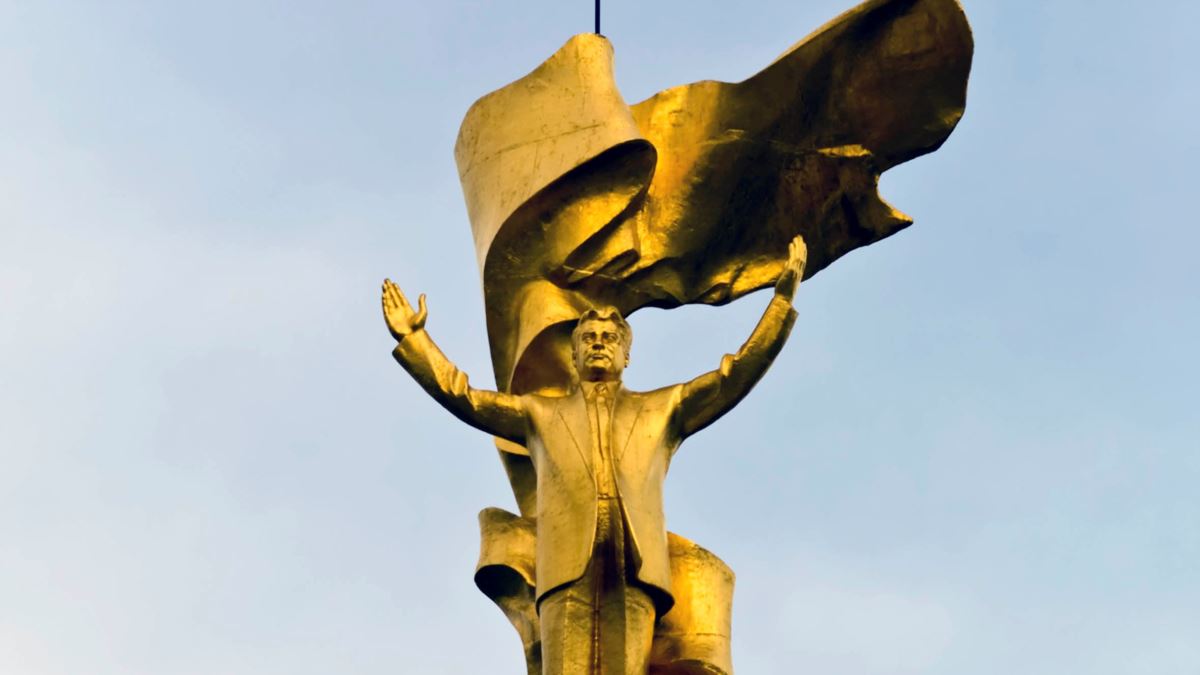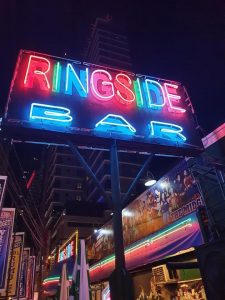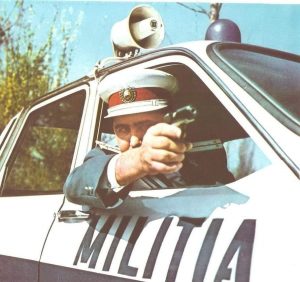When most people think about Turkmenistan, they immediately think about Turkmenbashy. Some of the Turkmenophiles out there will laugh, but there is a large number of tourists we encounter in Turkmenistan who still think it is Turkmenbashy in the top spot.
So, who was Turkmenbashy?
Well, firstly, Turkmenbashy is not his original name. His original name is Saparmurat Atayevich Niyazov. He was given his title Turkmenbashy, which means the leader of all Turkmen, by the world Association of Turkmens, an organization he founded and headed. He was also the first President of Turkmenistan from its Independence in 1991 until his early death in 2006.
Turkmenbashy was born in a small village just west of Ashgabat, called Kipchak, in 1940. This is the same village where the Turkmenbashy Mosque and Mausoleum are now located, built there in his honour. His father, Atamurat Niyazov, reportedly died during World War II, although some historians have claimed this may not be exactly true. Theories range from him being a drunk, to being court marshalled for trying to avoid conscription, but regardless, those don’t sit quite as well in the story of the founder of the country.
In 1948, one of the biggest earthquakes ever hit Turkmenistan, destroying almost every building and killing 80% of the population. Turkmenbashy survived; however, his brothers and mother all died in the earthquake, meaning Turkmenbashy was an orphan for the rest of his childhood.
Turkmenbashy then followed the normal Soviet route to power. He studied in Russia (Leningrad), and went on to be a local union leader, before slowly climbing the communist party ladder, first at the local level in Ashgabat and then at the national level in the Turkmen SSR. Finally, he became General Secretary of the Turkmen SSR Communist Party in 1985, and effectively the leader of the country within the Soviet Union
Turkmenbashy was appointed as the General Secretary of the Turkmen division of the Communist Party by Mikhail Gorbachev, after Gorbachev had fired Turkmenbashy’s predecessor Muhammetnazar Gapurov for corruption relating to cotton production. Funnily enough, this is almost the same story as what happened in 1986 in Kazakhstan when Gorbachev fired Dinmuhammed Kunayev. It was a pretty common occurrence during the 80s.
Turkmenbashy then went on to be a hardliner who opposed Gorbachev’s perestroika and glasnost. He also supported the coup in 1991 against Gorbachev, but when it failed, he decided that Turkmenistan’s future lay in Independence. In 1992 the first election was held, and Saparmurat Niyazov was elected the first President of the newly Independent Turkmenistan with a resounding 99.5% of the vote. He was, of course, the only candidate. This would be the last Presidential election until 2007, not surprisingly since in 1994, a referendum was held to extend Turkmenbashy’s term for 10 years. And if you wondered where he could go from 99.5% approval, well in the 1994 referendum, he received 99.9% support.
Finally, in 1999 he was declared President for Life!
This is where things get a little strange. During his Presidency, Turkmenbashy became increasingly irrational. Obviously, the first step was that he essentially gave himself the title Turkmenbashy (in case you hadn’t quite picked up on that before – he was the founder and leader of the organisation which gave him that name). He then wrote the Ruhnama, which in English translates to Book of the Soul, (which you can read about at this blog) a book which promoted a pseudoscientific explanation of where the Turkmen people came from, as well as Turkmenbashy’s own observations and advice, a lot of which quite frankly are the incoherent rantings of a madman.
Nonetheless, though, incoherent or not, passages from the Ruhnama had to be read and memorized in order to pass exams at school or university, to get a driver’s licence, to obtain any job, and basically to do anything in Turkmenistan. There was even a giant version of the book built in Independence Park as a monument to it, which opened every evening while passages of the book were readout. Sadly for us, those readings don’t happen anymore, and the book no longer opens, but it’s possibly still the biggest book you’ve ever seen, and we definitely still visit it on every tour!
He then started to implement some of the most insane aspects of his personality cult, including changing the names of the days of the week to his own and his family members’ names. He also changed the months of the year in the same manner. Turkmenbashy banned hospitals and libraries outside of Ashgabat. He banned gold teeth, dogs, opera, the circus and women wearing makeup on television. The white marble Ashgabat we know and love today was planned and began to be constructed under Turkmenbashy, as well as the amazing Avaza resort on the Caspian Sea.
Stories began to emerge of sheer madness, such as that of the town of Darvaza. According to legend, Turkmenbashy was driving through this town and decided he didn’t like it, so he had it completely removed, and now the only evidence that there was ever anything there are a few small structures such as chimneys. And yes, this is the Darvaza for which the Gates of Hell is named.
Many towns and villages across Turkmenistan were renamed to things like Saparmurat, Niyazov and Turkmenbashy. The Arch of Neutrality was also built featuring a gold statue of the man himself, which rotated to always face the sun. You can still see this amazing monument, but unfortunately, it doesn’t rotate anymore. Some other changes he made included banning lip-syncing (I think this is one lots of us would like to get behind), he also banned long hair and beards, and he even changed the Turkmen word for bread to his mother’s name – Gurbansoltan.
In 2002 Turkmenbashy survived an alleged attack. According to Turkmen sources, his motorcade was ambushed as he was driving through Ashgabat. Several sources claim it was staged to consolidate power. However, Turkmenbashy himself claimed it was a coup led by his ungrateful and corrupt former Minister of Foreign Affairs.
In Kipchak, the town of his birth, Turkmenbashy built a mosque, aptly named of course Turkmenbashy Mosque. It looks like a mosque and has all the general attributes of a mosque – dome, minarets, minibar, mihrab, etc. There are even two levels – the main one for men and the upper one for women, cleaning facilities, and basically everything else that you’d expect from a mosque. However, all the inscriptions throughout the mosque complex are not from the Quran, but instead from the Ruhnama. And instead of being dedicated to Allah and Islam, it is very clearly devoted to Turkmenbashy
In December 2006, Saparmurat Niyazov Turkmenbashy, the Great died of a heart attack prematurely at the age of 66. It was only 7 years after he was made President for Life. Since his death, almost all of his radical changes have been reversed, and now only a few gold statues of him remain, and a few place names remain the same, such as Turkmenbashy. The Ruhnama is no longer required reading and is now almost impossible to purchase. However, his vision of a white Ashgabat has very much been continued by his successor.
Turkmenbashy now lies in the specially built mausoleum with his family, right next to his mosque, in the village he was born in, which we, of course, visit on all tours


